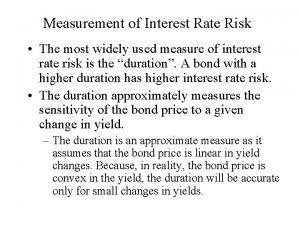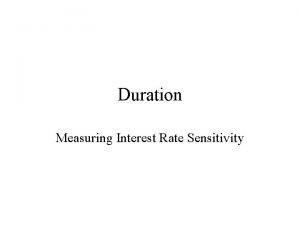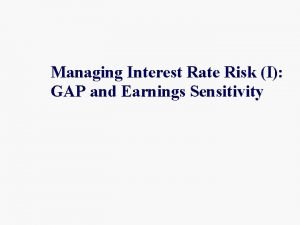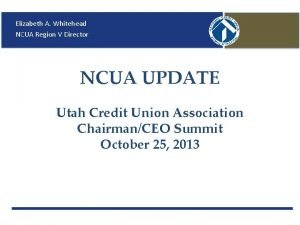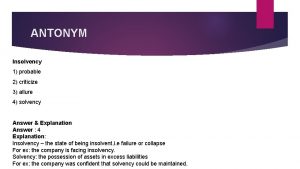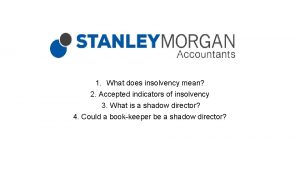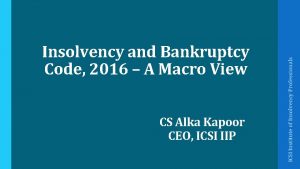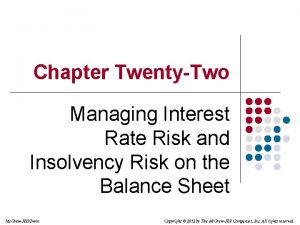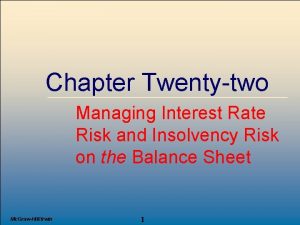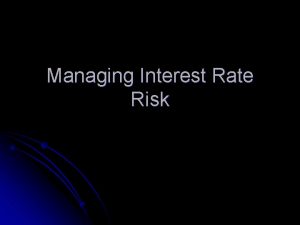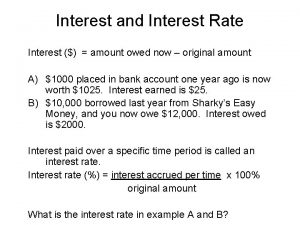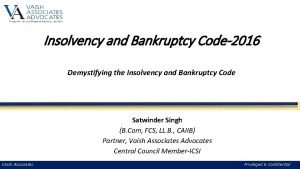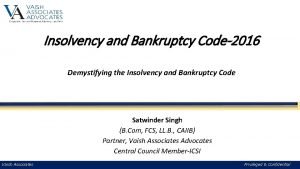Chapter Twentytwo Managing Interest Rate Risk and Insolvency














- Slides: 14

Chapter Twenty-two Managing Interest Rate Risk and Insolvency Risk on the Balance Sheet Mc. Graw-Hill/Irwin 1 © 2007, The Mc. Graw-Hill Companies, All Rights Reserved

Interest Rate Risk Measurement • Repricing or funding gap • Rate Sensitivity – the time to reprice an asset or liability – a measure of an FI’s exposure to interest rate changes in each maturity “bucket” – GAP can be computed for each of an FI’s maturity buckets Mc. Graw-Hill/Irwin 2 © 2007, The Mc. Graw-Hill Companies, All Rights Reserved

Calculating GAP for a Maturity Bucket NIIi = (GAP)i Ri = (RSAi - RSLi) Ri where NIIi = change in net interest income in the ith maturity bucket GAPi = dollar size of the gap between the book value of rate-sensitive assets and ratesensitive liabilities in maturity bucket i Ri = change in the level of interest rates impacting assets and liabilities in the ith maturity bucket Mc. Graw-Hill/Irwin 3 © 2007, The Mc. Graw-Hill Companies, All Rights Reserved

Simple Bank Balance Sheet and Repricing Gap Assets 1. Cash and due from 2. Short-term consumer loans (1 yr. maturity) 3. Long-term consumer loans (2 yr. maturity) 4. Three-month T-bills 5. Six-month T-notes 6. Three-year T-bonds 7. 10 -yr. Fixed-rate mort. 8. 30 -yr. Floating-rate m. 9. Premises Mc. Graw-Hill/Irwin Liabilities_____ $ 5 50 1. Two-year time deposits 2. Demand deposits 25 3. Passbook Savings 30 35 4. Three-month CDs 5. Three-month banker’s acceptances 6. Six-month commercial 7. One-year time deposits 8. Equity capital (fixed) 60 20 40 5 $270 $ 40 40 30 40 20 60 20 20 $270 4 © 2007, The Mc. Graw-Hill Companies, All Rights Reserved

Additional Terminology • Cumulative gap (CGAP): the cumulative GAP across various repricing categories or buckets • Spread effect: the effect that a change in the spread between rates on RSAs and RSLs has on net interest income (NII) as interest rates change Mc. Graw-Hill/Irwin 5 © 2007, The Mc. Graw-Hill Companies, All Rights Reserved

Four Major Weakness in the Repricing Model • Market value effects • Cash flow patterns within a maturity bucket • The problems of rate runoffs and prepayments • Cash flows from off-balance-sheet activities Mc. Graw-Hill/Irwin 6 © 2007, The Mc. Graw-Hill Companies, All Rights Reserved

Duration Model Duration gap - a measure of overall interest rate risk exposure for an FI D = _ % in the market value of a security R(1 + R) Mc. Graw-Hill/Irwin 7 © 2007, The Mc. Graw-Hill Companies, All Rights Reserved

Difficulties in Applying the Duration Model • Duration matching can be costly • Immunization is a dynamic problem • Large interest rate changes and convexity Mc. Graw-Hill/Irwin 8 © 2007, The Mc. Graw-Hill Companies, All Rights Reserved

Insolvency Risk Management • Net worth • Book Value • Market value or mark-to-market value basis Mc. Graw-Hill/Irwin 9 © 2007, The Mc. Graw-Hill Companies, All Rights Reserved

Effects of Changes in Loan Values and Interest Rates on the Balance Sheet Assets Base case Long-term securities Long-term bonds Liabilities $ 80 20 $100 Short-term floating Net worth $ 90 10 $100 After a major decline in value of loans Long-term securities Long-term bonds $ 80 8 $88 Liabilities Net worth $90 -2 $88 Liabilities Net worth $90 2 $92 After a rise in interest rates Long-term securities Long-term loans Mc. Graw-Hill/Irwin $ 75 17 $92 10 © 2007, The Mc. Graw-Hill Companies, All Rights Reserved

The Book Value of Capital • The book value of capital usually comprises three components in banking – Par value of shares – Surplus value of shares – Retained earnings • Book value of its capital and credit risk • Book value of capital and interest rate risk Mc. Graw-Hill/Irwin 11 © 2007, The Mc. Graw-Hill Companies, All Rights Reserved

The Discrepancy between the Market and Book Values of Equity • The degree to which the book value of an FI’s capital deviates from its true economic market value depends on a number of values – Interest Rate Volatility – Examination and Enforcement – Loan Trading Mc. Graw-Hill/Irwin 12 © 2007, The Mc. Graw-Hill Companies, All Rights Reserved

Calculating Discrepancy Between Book Values (BV) and Market Values (MV) MV = Market value of equity ownership in shares outstanding Number of shares BV = Par value of equity + Surplus value + Retained earnings_ ____ Number of shares Market-to-book ratio A ratio that shows the discrepancy between the stock market value of an FI’s equity and the book value of its equity Mc. Graw-Hill/Irwin 13 © 2007, The Mc. Graw-Hill Companies, All Rights Reserved

Arguments against Market Value Accounting • Difficulty of implementation • Introduces unnecessary degree of variability into an FI’s net worth • FI’s are less willing to accept longerterm asset exposures Mc. Graw-Hill/Irwin 14 © 2007, The Mc. Graw-Hill Companies, All Rights Reserved
 Nominal v. real interest rates
Nominal v. real interest rates Cap rate interest rate relationship
Cap rate interest rate relationship Measuring interest rate risk
Measuring interest rate risk Hedging interest rate risk with futures
Hedging interest rate risk with futures Interest rate risk sensitivity analysis
Interest rate risk sensitivity analysis Interest rate risk sensitivity analysis
Interest rate risk sensitivity analysis Maturity gap
Maturity gap Interest rate risk credit unions utah
Interest rate risk credit unions utah How to find the price of a bond
How to find the price of a bond Global insolvency practice course
Global insolvency practice course Global insolvency practice course
Global insolvency practice course Insolvency antonym
Insolvency antonym Dikesh bulsara
Dikesh bulsara Association of independent insolvency practitioners
Association of independent insolvency practitioners Icsiiip
Icsiiip


